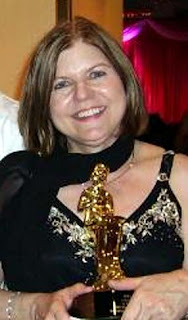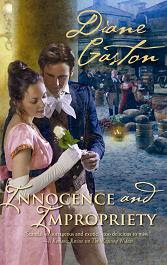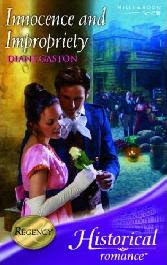 Today we’re interviewing RITA award winning author Diane Gaston, who has been known to impersonate that other fabulous Risky author Diane Perkins on occasion. Learn more about Diane and her books at www.dianegaston.com.
Today we’re interviewing RITA award winning author Diane Gaston, who has been known to impersonate that other fabulous Risky author Diane Perkins on occasion. Learn more about Diane and her books at www.dianegaston.com.
Diane is going to tell us about her new release, INNOCENCE & IMPROPRIETY. Leave an original, meaningful comment for the chance to win one of either the Mills & Boon or the Harlequin Historicals versions of the book. Winners will be selected based on comments left between February 25 and 28 and will be announced March 1.
 “For an engaging romance with moments of suspense and danger, I highly recommend INNOCENCE AND IMPROPRIETY.” Jane Bowers, Romance Reviews Today
“For an engaging romance with moments of suspense and danger, I highly recommend INNOCENCE AND IMPROPRIETY.” Jane Bowers, Romance Reviews Today
How did you think of writing this particular book? Did it start with a character, a setting, or some other element?
I wanted to stay in the world I’d created with THE MYSTERIOUS MISS M, THE WAGERING WIDOW and A REPUTABLE RAKE, so I looked for a character from A REPUTABLE RAKE who needed a romance. I picked Rose, one of the courtesan students.
In A REPUTABLE RAKE, Rose wanted to be a singer and she had already sung at Vauxhall Gardens, so that was a logical place for the story to start. I just had to figure out who deserved to be her hero.
How long did it take? Was this an easy or difficult book to write?
I can’t remember exactly how long it took to write. I generally allot 4 months to write a Harlequin/Mills & Boon book, but that includes all the interferences life tosses at us (and a lot of Scrabble Blast playing).
There were difficult parts to INNOCENCE AND IMPROPRIETY, but they also were the parts that make writing historicals fun. I had to learn about Vauxhall Gardens, well enough to move my characters around the Gardens, and I had to learn about Kings Theatre and the Opera and singing, all things I really knew nothing about.
 “Brilliant writing, a classic reformed rake plot, and vivid depictions of the Regency period make this a compelling read for fans of this era.” Romantic Times BOOKclub on THE REPUTABLE RAKE
“Brilliant writing, a classic reformed rake plot, and vivid depictions of the Regency period make this a compelling read for fans of this era.” Romantic Times BOOKclub on THE REPUTABLE RAKE
Tell me more about your characters. What or who inspired them?
I’d created Rose for A REPUTABLE RAKE, so all I needed to do for her was flesh out her character and backstory a little. It was a little more difficult to figure out who could be her hero. I like to stay true to my vision of what society was like in the Regency, so I did not think her hero would be a titled lord. Because she was Irish, I thought an Irish hero would be nice. Rose was strikingly beautiful, the most beautiful of the courtesan students in A Reputable Rake, so it stood to reason that she would attract male admiration. So I came up with the idea of a marquis who was smitten with her, but it was his Irish secretary who fell in love with her.
The original conflict was that the marquis, Tanner, wanted Rose for his latest mistress, but he needed his secretary, Flynn, to make the arrangements. The story needed more, though, so I threw in another rival. The sadistic Greythorne from THE MYSTERIOUS MISS M and my eHarlequin Daily Read, THE DIAMOND, was a tailor-made villain. He needed to be vanquished once and for all.
My favorite character was Tanner. By the end of chapter one I knew Tanner needed a book of his own!
Did you run across anything new and unusual while researching this book?
The other performers in INNOCENCE AND IMPROPRIETY were real people who actually performed at Vauxhall Gardens and King’s Theatre. It was fun to include them!
What do you think is the greatest creative risk you’ve taken in this book? How do you feel about it?
The biggest risk was choosing a non-traditional hero and heroine. An Irish secretary was not your typical Regency hero. Flynn was without the power of a gentleman with a title and I just wasn’t certain if readers would like that. Rose as a heroine was less of a risk, but again, as a singer, she was not typical of Regencies I’ve read.
I’m still wondering what readers will think of Rose and Flynn!
 “Perkins takes a standard marriage of convenience plot and brilliantly turns it into an emotionally intense, utterly captivating story that will thrill readers to their core.” — Kathe Robin, Romantic Times BOOKclub on THE MARRIAGE BARGAIN
“Perkins takes a standard marriage of convenience plot and brilliantly turns it into an emotionally intense, utterly captivating story that will thrill readers to their core.” — Kathe Robin, Romantic Times BOOKclub on THE MARRIAGE BARGAIN
What are you working on next?
I just turned in Tanner’s story! (titled THE VANISHING VISCOUNTESS). Tanner rescues a lady fugitive from a shipwreck and decides to help her escape to Scotland.
I’m also putting the finishing touches on my next Warner book. Remember the Ternion from THE MARRIAGE BARGAIN? DESIRE IN HIS EYES tells Blake’s story. Blake meets a woman he cannot resist–an imposter and a thief.
 How does your Gaston writing style differ from your Perkins writing style?
How does your Gaston writing style differ from your Perkins writing style?
There is no difference in style between the writing in my Gaston books and my Perkins books. My Perkins books are slightly less risky and tend to have more traditional characters and settings. Of course, DESIRE IN HIS EYES has a con artist as a heroine. Not too traditional.
What did you think of 300?
Only 13 more days to go!!! Then I’ll tell you.
Thanks, Diane!
Remember to comment for the chance to win a copy of either the the Harlequin Historicals or Mills & Boon version of INNOCENCE AND IMPROPRIETY! Contest ends February 28.
 Last week during Megan’s post on historical accuracy Cara and Kalen both talked about errors regarding horses, like the Bionic Horse that can gallop for hours nonstop. It got me thinking about some of the other howlers I’ve read.
Last week during Megan’s post on historical accuracy Cara and Kalen both talked about errors regarding horses, like the Bionic Horse that can gallop for hours nonstop. It got me thinking about some of the other howlers I’ve read. But these are really minor gaffes compared to the abuse of terms for horses themselves.
But these are really minor gaffes compared to the abuse of terms for horses themselves. Confusing a pony with a baby horse. A baby horse is called a foal (or colt if male, filly if female). This is a foal. No one in his right mind would put a child or small adult on its back.
Confusing a pony with a baby horse. A baby horse is called a foal (or colt if male, filly if female). This is a foal. No one in his right mind would put a child or small adult on its back.
 Stallions can be extremely trainable and responsive mounts. While I was in England I was lucky enough to see Jennie Loriston-Clarke riding her glorious stallion, Dutch Courage. The rapport between those two was a wonder to behold.
Stallions can be extremely trainable and responsive mounts. While I was in England I was lucky enough to see Jennie Loriston-Clarke riding her glorious stallion, Dutch Courage. The rapport between those two was a wonder to behold.






